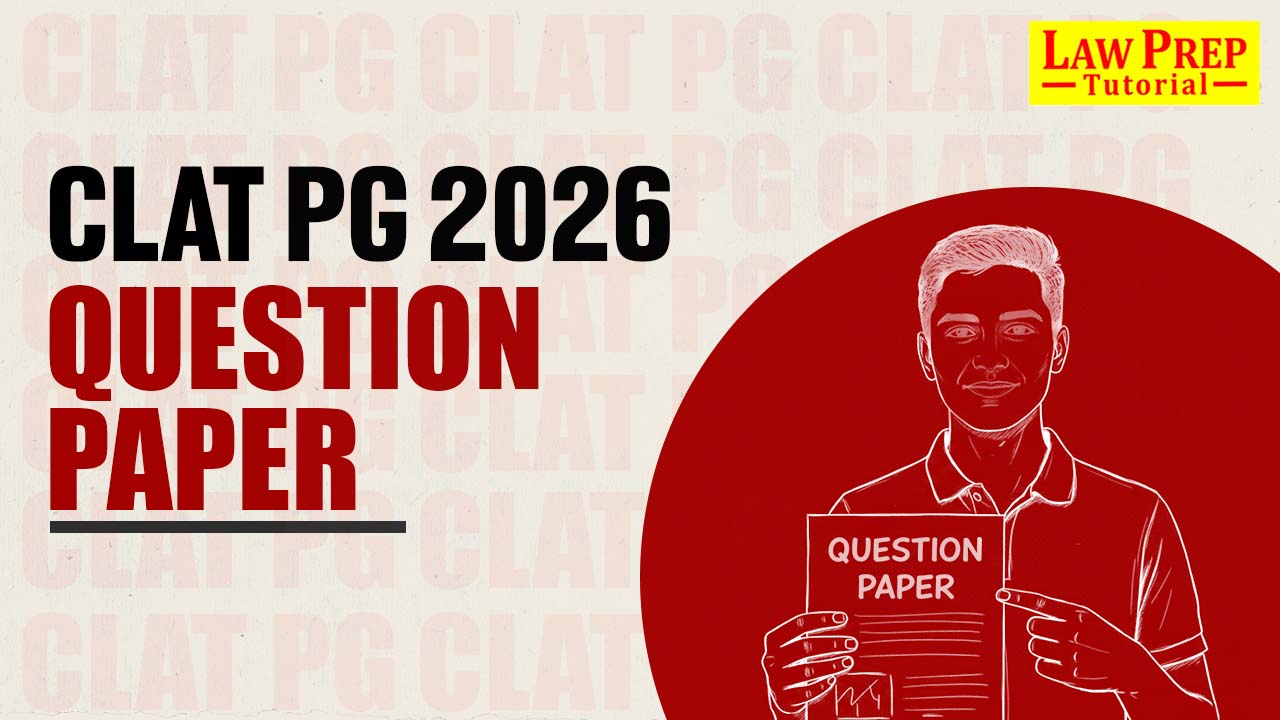CLAT PG Previous Year Papers With Solutions (2021-2026)
Free PDFs
(2021–2026)
Official CLAT
PG question papers
Answer key
& detailed solutions
Need help in your CLAT Preparation? Book Free Counselling Session!
Benefits of Practicing with CLAT PG Previous Year Question Paper
Understand Real Exam Pattern
Practicing CLAT PG previous year paper sets gives you firsthand experience of the actual structure, question type, and marking scheme. It helps you understand how questions are framed in the CLAT PG papers and prepares you to manage your time efficiently during the real test.
Identify High-Weightage Topics
When you go through CLAT PG previous year question papers, you’ll easily spot the subjects that appear most often, like Constitutional Law, Jurisprudence, and Criminal Law. This helps you focus more on high-yield areas instead of wasting time on low-priority topics.
Boost Your Conceptual Clarity
Solving previous year papers of CLAT PG challenges your understanding of legal concepts, landmark judgments, and case law interpretation. When you attempt these questions regularly, your conceptual clarity improves, and you learn how to apply theory to practical legal scenarios.
Improve Accuracy and Speed
Practicing CLAT PG last year question paper under timed conditions enhances your speed and accuracy. You’ll learn to balance between conceptual questions and tricky options, making sure you can complete the exam within the given two hours.
Analyze Strengths and Weaknesses
When you attempt multiple CLAT PG PYQs, it becomes easier to evaluate where you’re strong and where you need improvement. This analysis helps you tweak your study plan to focus more on your weak subjects before the next mock or paper.
Experience Real Exam Pressure
By solving previous year CLAT PG question paper, you experience the same kind of pressure you’ll face on the actual day. This helps you handle anxiety, stay calm, and make better decisions even when the paper feels tough.
Learn the Examiner’s Mindset
The CLAT PG previous year question papers reveal how examiners think, what kind of reasoning they test, and how they twist straightforward legal principles. With regular practice, you’ll develop an instinct for identifying traps and interpreting complex legal questions correctly.
Track Your Progress Over Time
Regularly solving CLAT PG PYQ papers allows you to track your improvement. Comparing your past scores shows you how close you are to your target rank and motivates you to keep refining your preparation before the actual exam.
Book Free Counselling for CLAT PG Preparation!
CLAT PG Syllabus
| Core Subject / Area of Law | Approx. Weightage (Out of 120 Marks) | Remarks / Preparation Focus |
| Constitutional Law | 20–25 Marks | Most important section; expect direct and case-based questions. |
| Jurisprudence | 10–15 Marks | Focus on legal theories and philosophical schools of law. |
| Administrative Law | 5–8 Marks | Application-based questions on judicial review and natural justice. |
| Law of Contract | 8–10 Marks | Conceptual clarity and case law understanding are key. |
| Law of Torts | 5–8 Marks | Questions often revolve around doctrines and liabilities. |
| Family Law | 5 Marks | Covers both Hindu and Muslim law principles. |
| Criminal Law | 10–15 Marks | Case-driven questions from IPC and general principles. |
| Property Law | 5 Marks | Fundamental concepts from the Transfer of Property Act. |
| Company Law | 5–8 Marks | Based on corporate governance and statutory duties. |
| Public International Law | 5–8 Marks | Expect questions on treaties, jurisdiction, and state responsibility. |
| Tax Law | 3–5 Marks | Basic-level conceptual and application questions. |
| Environmental Law | 5–8 Marks | Recent judgments and sustainable development principles are crucial. |
| Labour & Industrial Law | 5 Marks | Focus on labour codes, industrial disputes, and trade unions. |
How to Use CLAT PG Question Paper Effectively for Prep?
1. Start with One Paper a Week
2. Analyze Every Paper in Detail
3. Maintain a Dedicated PYQ Notebook
4. Revise Concepts After Every Attempt
5. Focus on Landmark Judgments and Case Laws
6. Compare Your Approach with Model Answers
7. Mix PYQs with Mock Tests
8. Track Time and Create Exam Rhythm

Download CLAT PG Syllabus PDF!
- Get the detailed and well-structured syllabus for Free!
Common Question Types in CLAT PG
Principle-Based Legal Questions
You’ll get questions that provide a principle followed by a factual scenario. You must apply the legal rule to identify the correct outcome. These test your conceptual clarity and interpretation skills.
Case-Law Based Questions
Many questions are inspired by recent Supreme Court or High Court judgments. You must recognize the legal principle or landmark case referred to in the question.
Conceptual Theory Questions
These are straightforward questions testing your knowledge of definitions, doctrines, and legal theories — particularly from subjects like Jurisprudence and Constitutional Law.
Statutory Interpretation Questions
Here, you need to interpret the meaning of a statutory term or provision, often from Acts like the Contract Act, IPC, or Environmental Acts.
Analytical and Logical Application Questions
These require understanding the logical outcome of applying two or more legal principles together — testing your ability to connect multiple legal concepts.
Match the Following Questions
Sometimes, questions ask you to match case names with principles, articles with rights, or legal doctrines with examples.
Chronology or Assertion-Reason Questions
You may find questions asking for the correct sequence of constitutional amendments or reasoning behind landmark decisions.
Recent Legal Development Questions
CLAT PG often includes questions from new laws, amendments, and contemporary judgments, so staying updated with current legal affairs is vital.
CLAT PG Exam Pattern
| Particulars | Details |
| Exam Name | Common Law Admission Test for Postgraduate (CLAT PG) |
| Conducting Body | Consortium of NLUs |
| Purpose | Admission to LL.M. programs at 26 National Law Universities |
| Exam Level | National-level entrance exam |
| Mode of Exam | Offline (Pen and Paper) |
| Type of Questions | Multiple Choice Questions (MCQs) |
| Total Questions | 120 |
| Total Marks | 120 |
| Duration | 2 Hours (120 minutes) |
| Medium of Exam | English |
| Marking Scheme | +1 for each correct answer |
| Negative Marking | -0.25 for each incorrect answer |
| Tie-Breaking Criteria | Higher age, followed by computerized draw of lots |







